Kuppan T. Heat Exchanger Design Handbook
Подождите немного. Документ загружается.

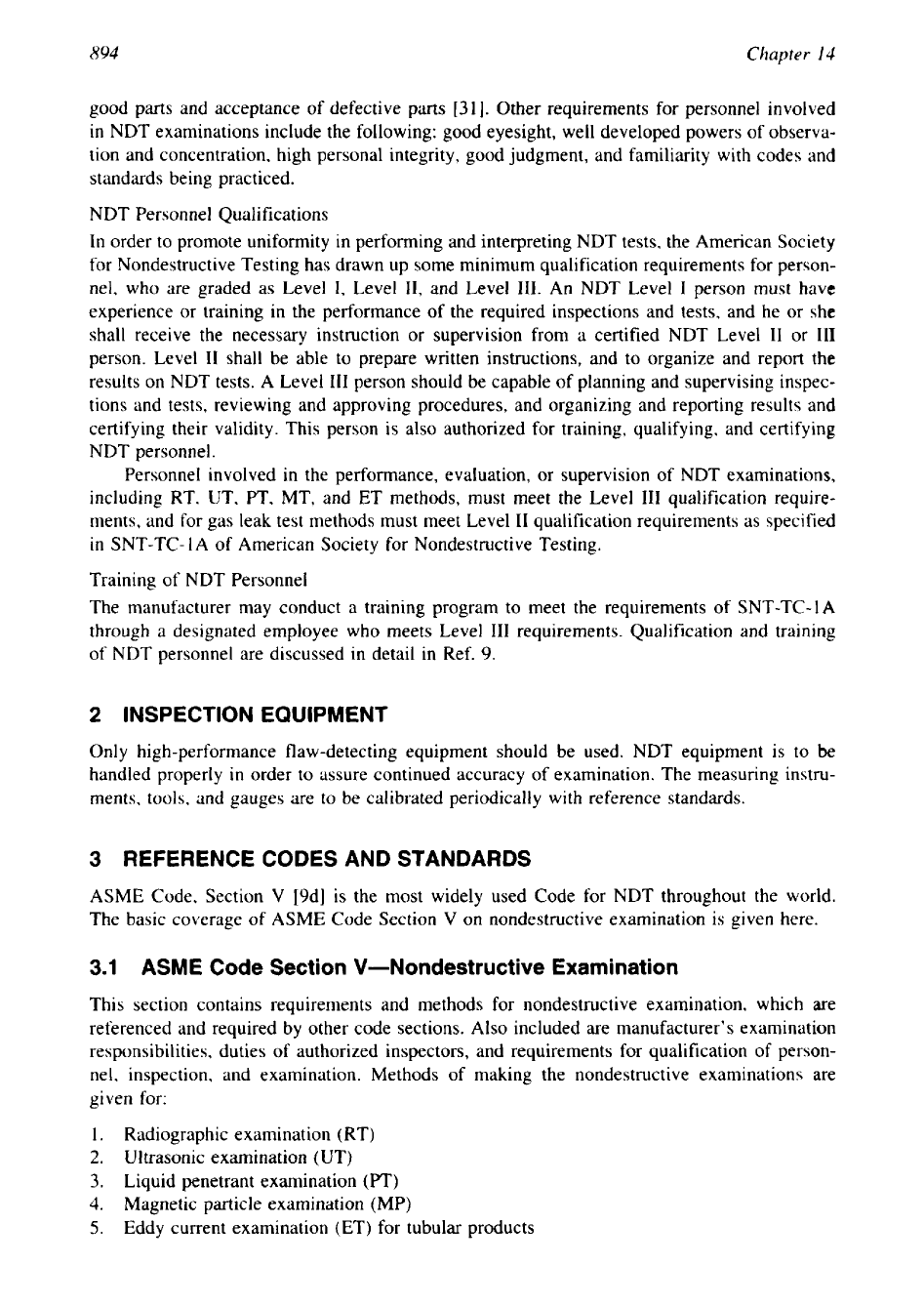
894
Chapter
14
good parts and acceptance of defective parts
[31].
Other requirements for personnel involved
in
NDT examinations include the following: good eyesight, well developed powers of observa-
tion and concentration, high personal integrity, good judgment, and familiarity with codes and
standards being practiced.
NDT Personnel Qualifications
In
order to promote uniformity
in
performing and interpreting NDT tests, the American Society
for Nondestructive Testing has drawn up some minimum qualification requirements for person-
nel, who are graded as Level
I,
Level
11,
and Level
111.
An NDT Level
I
person must have
experience or training in the performance of the required inspections and tests, and he or she
shall receive the necessary instruction or supervision from a certified NDT Level
I1
or
111
person. Level
I1
shall be able to prepare written instructions, and to organize and report the
results on NDT tests.
A
Level
111
person should be capable of planning and supervising inspec-
tions and tests, reviewing and approving procedures, and organizing and reporting results and
certifying their validity. This person is also authorized for training, qualifying, and certifying
NDT personnel.
Personnel involved in the performance, evaluation, or supervision of NDT examinations,
including RT,
UT.
PT,
MT, and ET methods, must meet the Level
I11
qualification require-
ments, and for gas leak test methods must meet Level
I1
qualification requirements as specified
in
SNT-TC-
1
A of American Society for Nondestructive Testing.
Training of NDT Personnel
The manufacturer may conduct
a
training program to meet the requirements of SNT-TC-
1
A
through
a
designated employee who meets Level
I11
requirements. Qualification and training
of NDT personnel are discussed in detail in Ref.
9.
2
INSPECTION EQUIPMENT
Only high-performance flaw-detecting equipment should be used. NDT equipment is to be
handled properly
in
order to assure continued accuracy of examination. The measuring instru-
ments, tools, and gauges are to be calibrated periodically with reference standards.
3
REFERENCE CODES AND STANDARDS
ASME Code, Section
V
[9d] is the most widely used Code for NDT throughout the world.
The basic coverage of ASME Code Section
V
on nondestructive examination is given here.
3.1
ASME Code Section V-Nondestructive Examination
This section contains requirements and methods for nondestructive examination, which are
referenced and required by other code sections. Also included are manufacturer’s examination
responsibilities, duties of authorized inspectors, and requirements for qualification of person-
nel, inspection, and examination. Methods of making the nondestructive examinations are
given for:
1. Radiographic examination (RT)
2.
Ultrasonic examination
(UT)
3.
Liquid penetrant examination
(PT)
4.
Magnetic particle examination (MP)
5.
Eddy current examination (ET) for tubular products
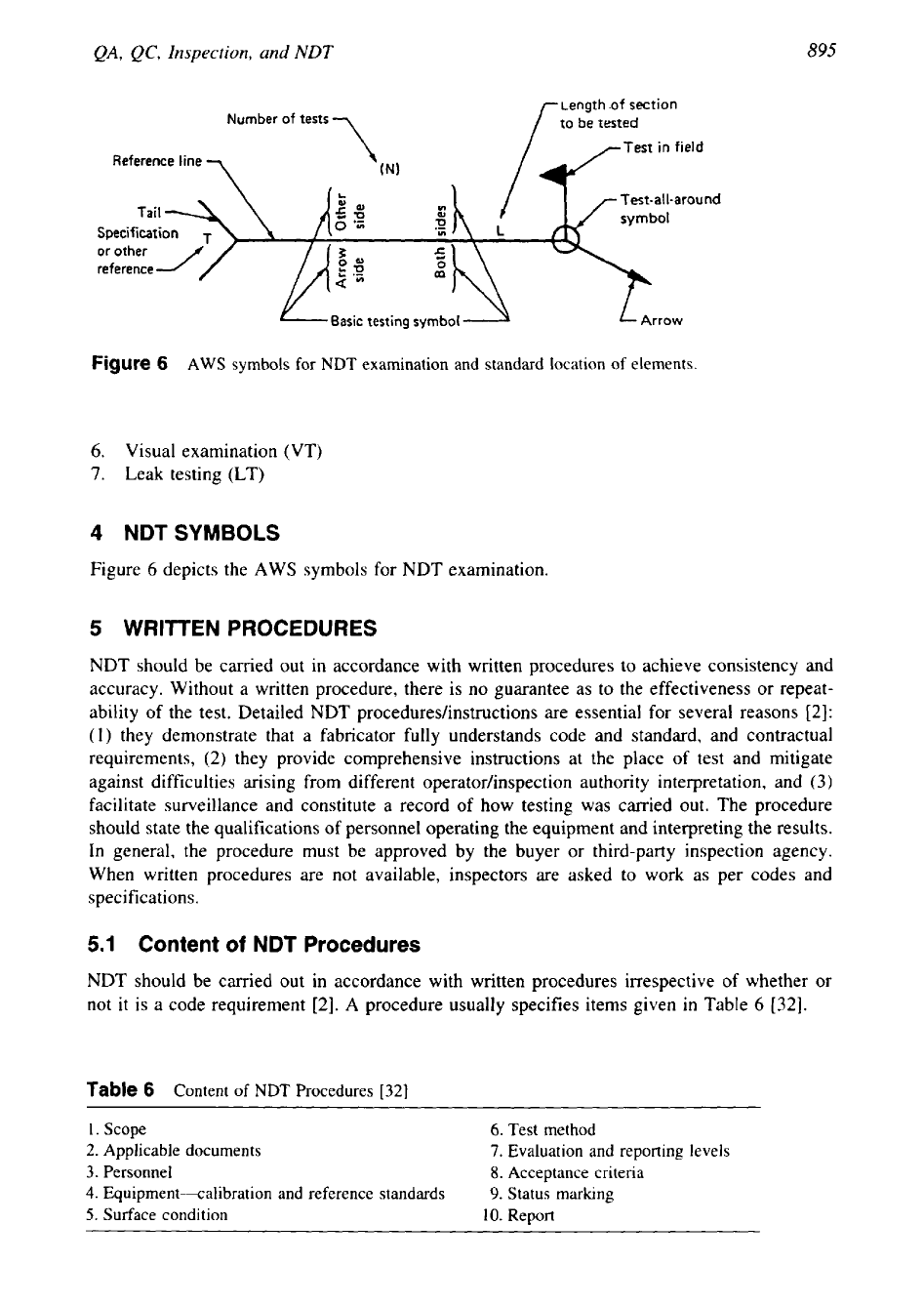
895
QA,
QC,
Inspection,
and
NDT
Length .of section
Number
of
tests
7
f
to be tested
Test in
field
Reference line
(NI
I
Basic testing symbol
Figure
6
AWS
symbols
for
NDT
examination and standard location
of
elements.
6.
Visual examination (VT)
7.
Leak testing (LT)
4
NDTSYMBOLS
Figure
6
depicts the AWS symbols for NDT examination.
5
WRITTEN
PROCEDURES
NDT should be carried out in accordance with written procedures to achieve consistency and
accuracy. Without a written procedure, there is no guarantee as to the effectiveness or repeat-
ability of the test. Detailed NDT procedures/instructions are essential for several reasons [2]:
(1)
they demonstrate that a fabricator fully understands code and standard, and contractual
requirements, (2) they provide comprehensive instructions at the place
of
test and mitigate
against difficulties arising from different operator/inspection authority interpretation, and
(3)
facilitate surveillance and constitute a record of how testing was carried out. The procedure
should state
the
qualifications of personnel operating the equipment and interpreting the results.
In general, the procedure must be approved by the buyer or third-party inspection agency.
When written procedures are not available, inspectors are asked to work as per codes and
specifications.
5.1 Content
of
NDT Procedures
NDT should be carried out in accordance with written procedures irrespective of whether or
not it is a code requirement [2]. A procedure usually specifies items given in Table
6
[32].
Table
6
Content of
NDT
Procedures
[32]
1.
Scope
6.
Test method
2.
Applicable documents
7.
Evaluation and reporting levels
3.
Personnel
8.
Acceptance criteria
4.
Equipment-calibration and reference standards
9.
Status marking
5.
Surface condition
10.
Report
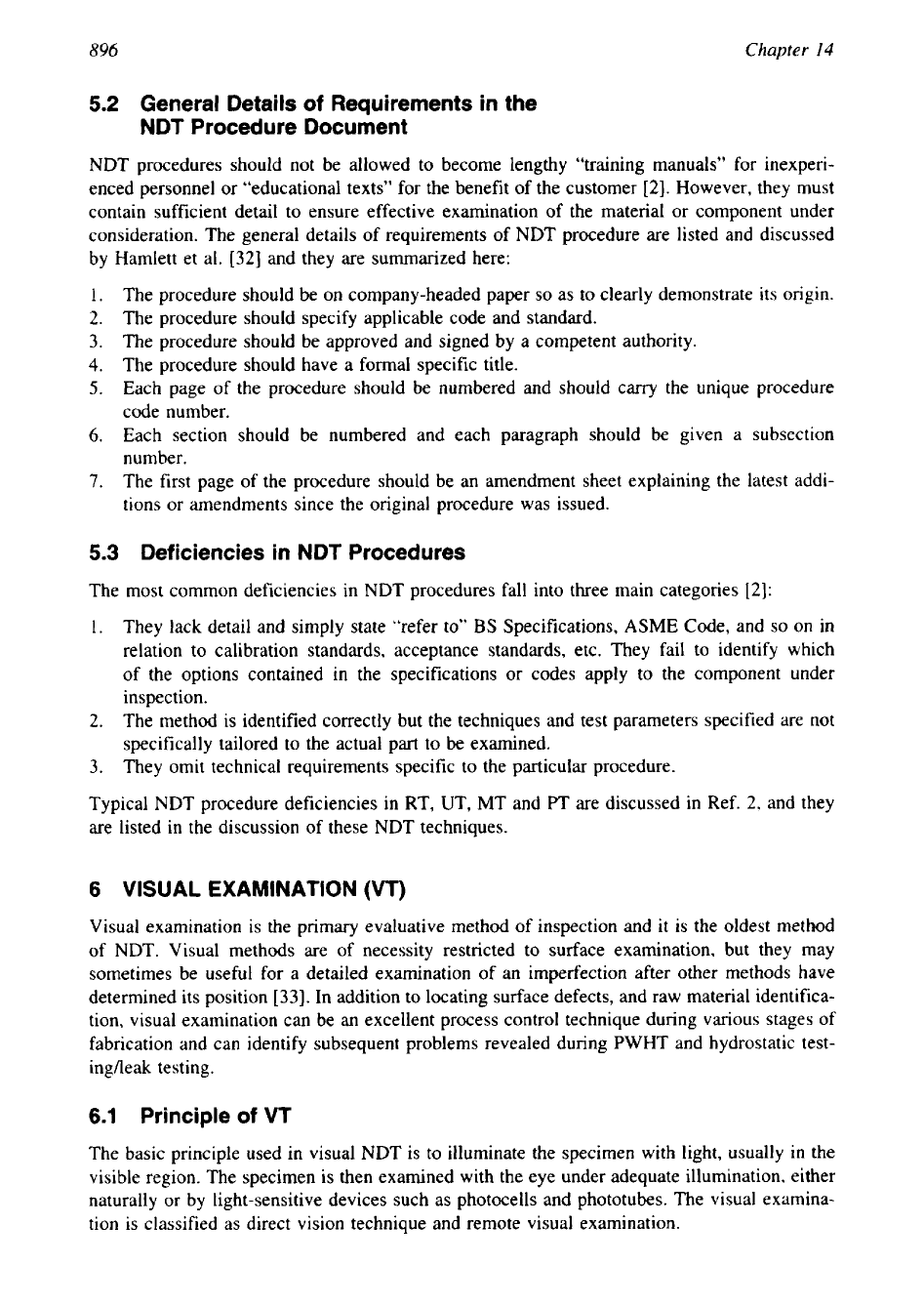
896
Chapter
14
5.2
General Details
of
Requirements in the
NDT Procedure Document
NDT procedures should not be allowed to become lengthy “training manuals” for inexperi-
enced personnel or “educational texts” for the benefit of the customer
[2].
However, they must
contain sufficient detail to ensure effective examination of the material or component under
consideration. The general details of requirements of NDT procedure are listed and discussed
by Hamlett et al.
[32]
and they are summarized here:
1. The procedure should be on company-headed paper
so
as to clearly demonstrate its origin.
2.
The procedure should specify applicable code and standard.
3.
The procedure should be approved and signed by a competent authority.
4.
The procedure should have a formal specific title.
5.
Each page of the procedure should be numbered and should carry the unique procedure
code number.
6.
Each section should be numbered and each paragraph should be given a subsection
number.
7. The first page of the procedure should be an amendment sheet explaining the latest addi-
tions or amendments since the original procedure was issued.
5.3
Deficiencies in NDT Procedures
The most common deficiencies in NDT procedures fall into three main categories
[2]:
1.
They lack detail and simply state “refer to”
BS
Specifications,
ASME
Code, and
so
on in
relation to calibration standards, acceptance standards, etc. They fail to identify which
of the options contained in the specifications or codes apply to the component under
inspection.
2.
The method is identified correctly but the techniques and test parameters specified are not
specifically tailored to the actual part to be examined.
3.
They omit technical requirements specific to the particular procedure.
Typical NDT procedure deficiencies in RT, UT, MT and
PT
are
discussed in Ref.
2,
and they
are listed in the discussion of these NDT techniques.
6
VISUAL EXAMINATION
(VT)
Visual examination is the primary evaluative method of inspection and it is the oldest method
of
NDT. Visual methods are of necessity restricted to surface examination, but they may
sometimes be useful for a detailed examination of an imperfection after other methods have
determined its position
[33].
In addition to locating surface defects, and raw material identifica-
tion, visual examination can be
an
excellent process control technique during various stages of
fabrication and can identify subsequent problems revealed during
PWHT
and hydrostatic test-
ing/leak testing.
6.1
Principle of
VT
The basic principle used in visual NDT is to illuminate the specimen with light, usually
in
the
visible region. The specimen is then examined with the eye under adequate illumination, either
naturally or by light-sensitive devices such as photocells and phototubes. The visual examina-
tion is classified as direct vision technique and remote visual examination.
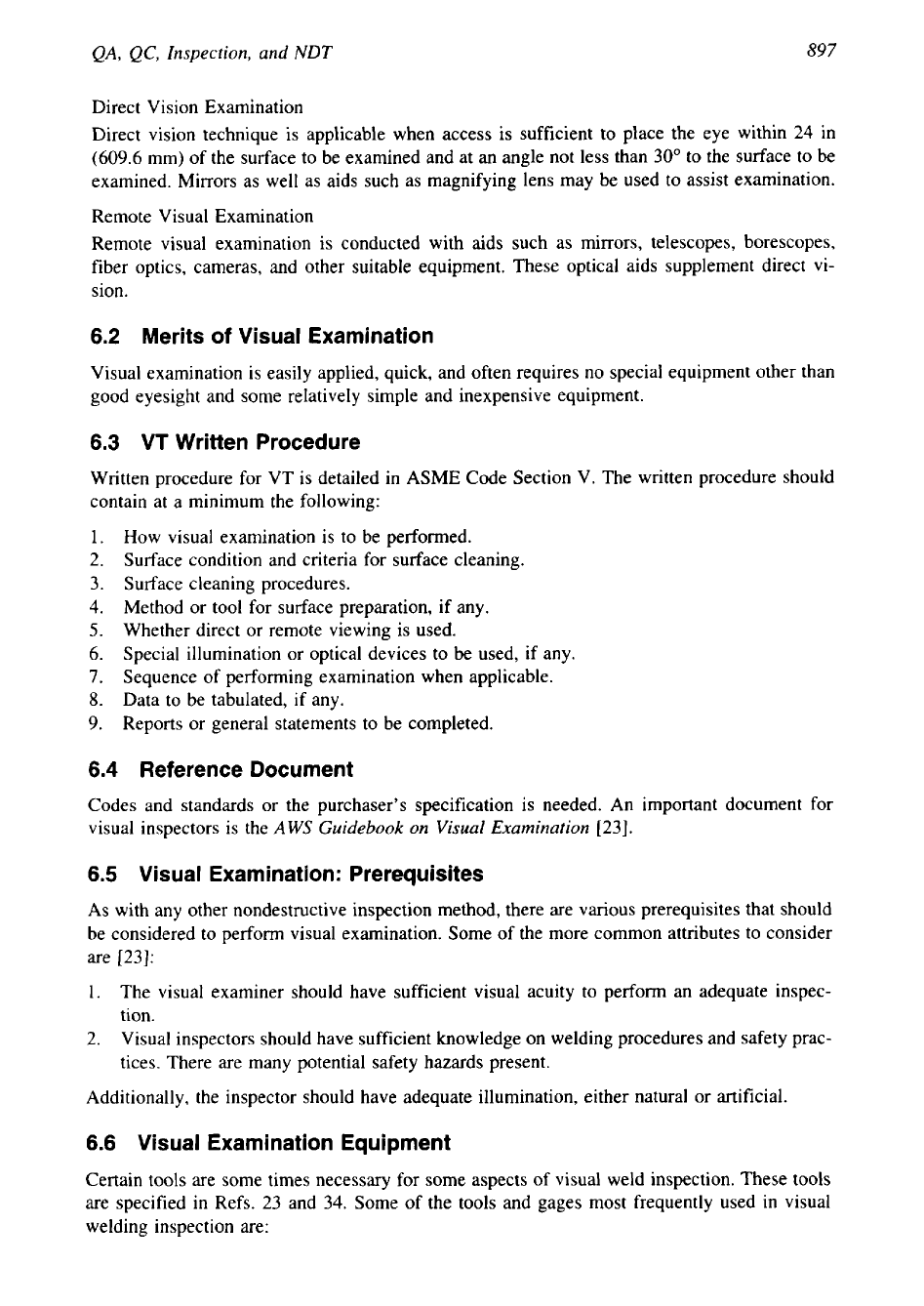
QA,
QC,
Inspection, and
NDT
897
Direct Vision Examination
Direct vision technique is applicable when access is sufficient to place the eye within
24
in
(609.6 mm) of the surface to be examined and at
an
angle not less than
30"
to the surface to be
examined. Mirrors as well as aids such as magnifying lens may be used to assist examination.
Remote Visual Examination
Remote visual examination is conducted with aids such as mirrors, telescopes, borescopes,
fiber optics, cameras, and other suitable equipment. These optical aids supplement direct vi-
sion.
6.2
Merits of Visual Examination
Visual examination is easily applied, quick, and often requires no special equipment other than
good eyesight and some relatively simple and inexpensive equipment.
6.3
VT Written Procedure
Written procedure for VT is detailed in
ASME
Code Section
V.
The written procedure should
contain at a minimum the following:
1.
How visual examination is to be performed.
2.
Surface condition and criteria for surface cleaning.
3.
Surface cleaning procedures.
4.
Method or tool for surface preparation, if any.
5.
Whether direct or remote viewing is used.
6.
Special illumination or optical devices to be used, if any
7.
Sequence of performing examination when applicable.
8.
Data to be tabulated, if any.
9.
Reports or general statements to be completed.
6.4
Reference Document
Codes and standards
or
the purchaser's specification is needed. An important document for
visual inspectors is the
A
WS
Guidebook
on
Visual Examination
[23].
6.5
Visual Examination: Prerequisites
As
with any other nondestructive inspection method, there are various prerequisites that should
be considered to perform visual examination. Some of the more common attributes to consider
are /23]:
1.
The visual examiner should have sufficient visual acuity to perform an adequate inspec-
tion.
2.
Visual inspectors should have sufficient knowledge on welding procedures and safety prac-
tices. There are many potential safety hazards present.
Additionally, the inspector should have adequate illumination, either natural or artificial.
6.6
Visual Examination Equipment
Certain tools are some times necessary for some aspects of visual weld inspection. These tools
are specified in Refs. 23 and 34. Some of the tools and gages most frequently used in visual
welding inspection are:
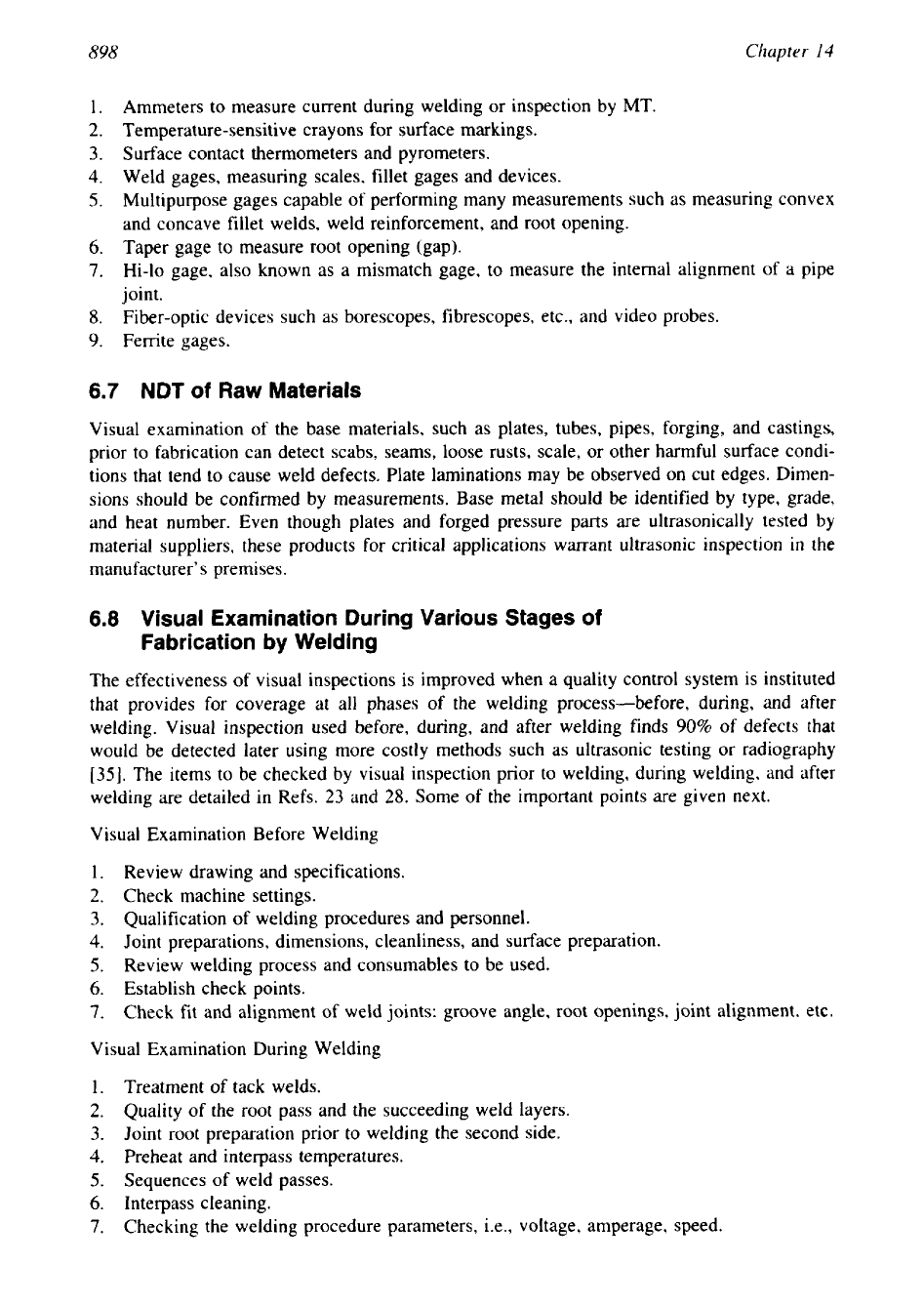
898
Chapter
I4
1. Ammeters to measure current during welding or inspection by MT.
2.
Temperature-sensitive crayons for surface markings.
3.
Surface contact thermometers and pyrometers.
4.
Weld gages, measuring scales. fillet gages and devices.
5.
Multipurpose gages capable of performing many measurements such as measuring convex
and concave fillet welds, weld reinforcement, and root opening.
6.
Taper gage to measure root opening (gap).
7.
Hi-lo gage, also known as a mismatch gage, to measure the internal alignment of a pipe
joint.
8.
Fiber-optic devices such as borescopes, fibrescopes, etc., and video probes.
9.
Ferrite gages.
6.7
NDT
of
Raw Materials
Visual examination of the base materials, such as plates, tubes, pipes, forging, and castings,
prior to fabrication can detect scabs, seams, loose rusts, scale, or other harmful surface condi-
tions that tend to cause weld defects. Plate laminations may be observed on cut edges. Dimen-
sions should be confirmed by measurements. Base metal should be identified by type, grade,
and heat number. Even though plates and forged pressure parts are ultrasonically tested by
material suppliers, these products for critical applications warrant ultrasonic inspection
in
the
manufacturer’s premises.
6.8
Visual Examination During Various Stages
of
Fabrication
by
Welding
The effectiveness of visual inspections is improved when a quality control system is instituted
that provides for coverage at all phases of the welding process-before, during, and after
welding. Visual inspection used before, during, and after welding finds
90%
of defects that
would be detected later using more costly methods such as ultrasonic testing or radiography
[35].
The items to be checked by visual inspection prior to welding, during welding, and after
welding are detailed in Refs.
23
and
28.
Some of the important points are given next.
Visual Examination Before Welding
1.
Review drawing and specifications,
2.
Check machine settings.
3.
Qualification of welding procedures and personnel.
4.
Joint preparations, dimensions, cleanliness, and surface preparation.
5.
Review welding process and consumables to be used.
6.
Establish check points.
7.
Check fit and alignment of weld joints: groove angle, root openings, joint alignment, etc.
Visual Examination During Welding
1.
Treatment of tack welds.
2.
Quality of the root pass and the succeeding weld layers.
3.
Joint root preparation prior to welding the second side.
4.
Preheat and interpass temperatures.
5.
Sequences of weld passes.
6.
Interpass cleaning.
7.
Checking the welding procedure parameters, i.e., voltage, amperage, speed.
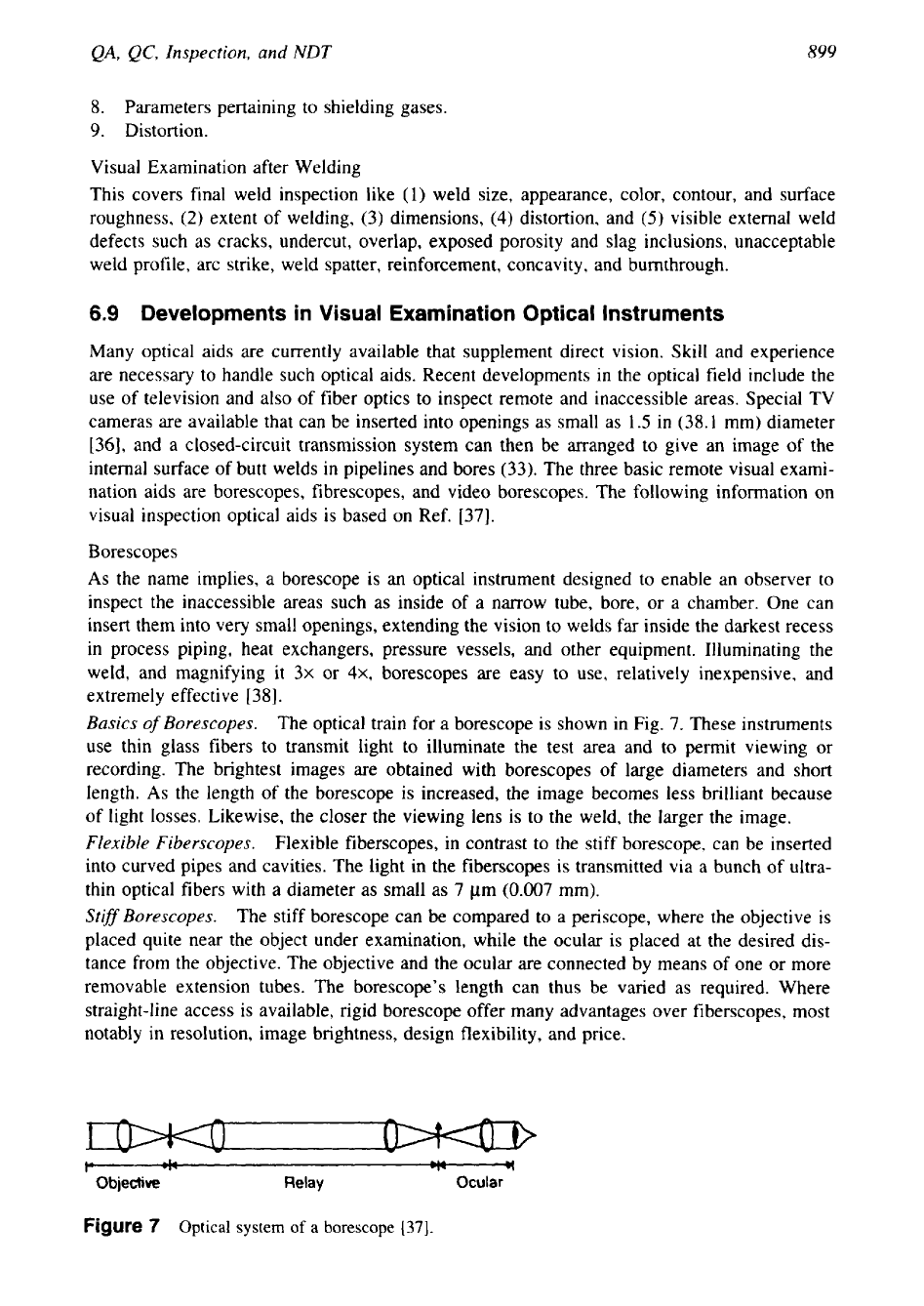
QA,
QC, Inspection, and
NDT
899
8.
Parameters pertaining to shielding gases.
9.
Distortion.
Visual Examination after Welding
This covers final weld inspection like
(1)
weld size, appearance, color, contour, and surface
roughness,
(2)
extent of welding,
(3)
dimensions, (4) distortion, and
(5)
visible external weld
defects such as cracks, undercut, overlap, exposed porosity and slag inclusions, unacceptable
weld profile, arc strike, weld spatter, reinforcement, concavity, and burnthrough.
6.9
Developments
in
Visual Examination Optical Instruments
Many optical aids are currently available that supplement direct vision. Skill and experience
are necessary to handle such optical aids. Recent developments in the optical field include the
use of television and also of fiber optics to inspect remote and inaccessible areas. Special TV
cameras are available that can be inserted into openings as small as
1.5
in (38.1 mm) diameter
[36], and a closed-circuit transmission system can then be arranged to give an image of the
internal surface of butt welds in pipelines and bores
(33).
The three basic remote visual exami-
nation aids are borescopes, fibrescopes, and video borescopes. The following information on
visual inspection optical aids is based on Ref. [37].
Borescopes
As
the name implies, a borescope is
an
optical instrument designed to enable an observer to
inspect the inaccessible areas such as inside
of
a narrow tube, bore, or a chamber. One can
insert them into very small openings, extending the vision to welds far inside the darkest recess
in process piping, heat exchangers, pressure vessels, and other equipment. Illuminating the
weld, and magnifying it 3x or 4x, borescopes are easy to use, relatively inexpensive, and
extremely effective [38].
Basics
of
Borescopes.
The optical train for a borescope is shown in Fig. 7. These instruments
use thin glass fibers to transmit light to illuminate the test area and to permit viewing or
recording. The brightest images are obtained with borescopes
of
large diameters and short
length.
As
the length of the borescope is increased, the image becomes less brilliant because
of light losses. Likewise, the closer the viewing lens is to the weld, the larger the image.
Flexible Fiberscopes.
Flexible fiberscopes, in contrast to the stiff borescope, can be inserted
into curved pipes and cavities. The light in the fiberscopes is transmitted via a bunch of ultra-
thin optical fibers with a diameter as small as 7 pm (0.007 mm).
StiffBorescopes.
The stiff borescope can be compared to a periscope, where the objective is
placed quite near the object under examination, while the ocular is placed at the desired dis-
tance from the objective. The objective and the ocular are connected by means
of
one or more
removable extension tubes. The borescope's length can thus be varied as required. Where
straight-line access is available, rigid borescope offer many advantages over fiberscopes, most
notably in resolution, image brightness, design flexibility, and price.
r
I-
I-
Objective
Relay
Ocular
Figure
7
Optical
system
of
a
borescope
[37].
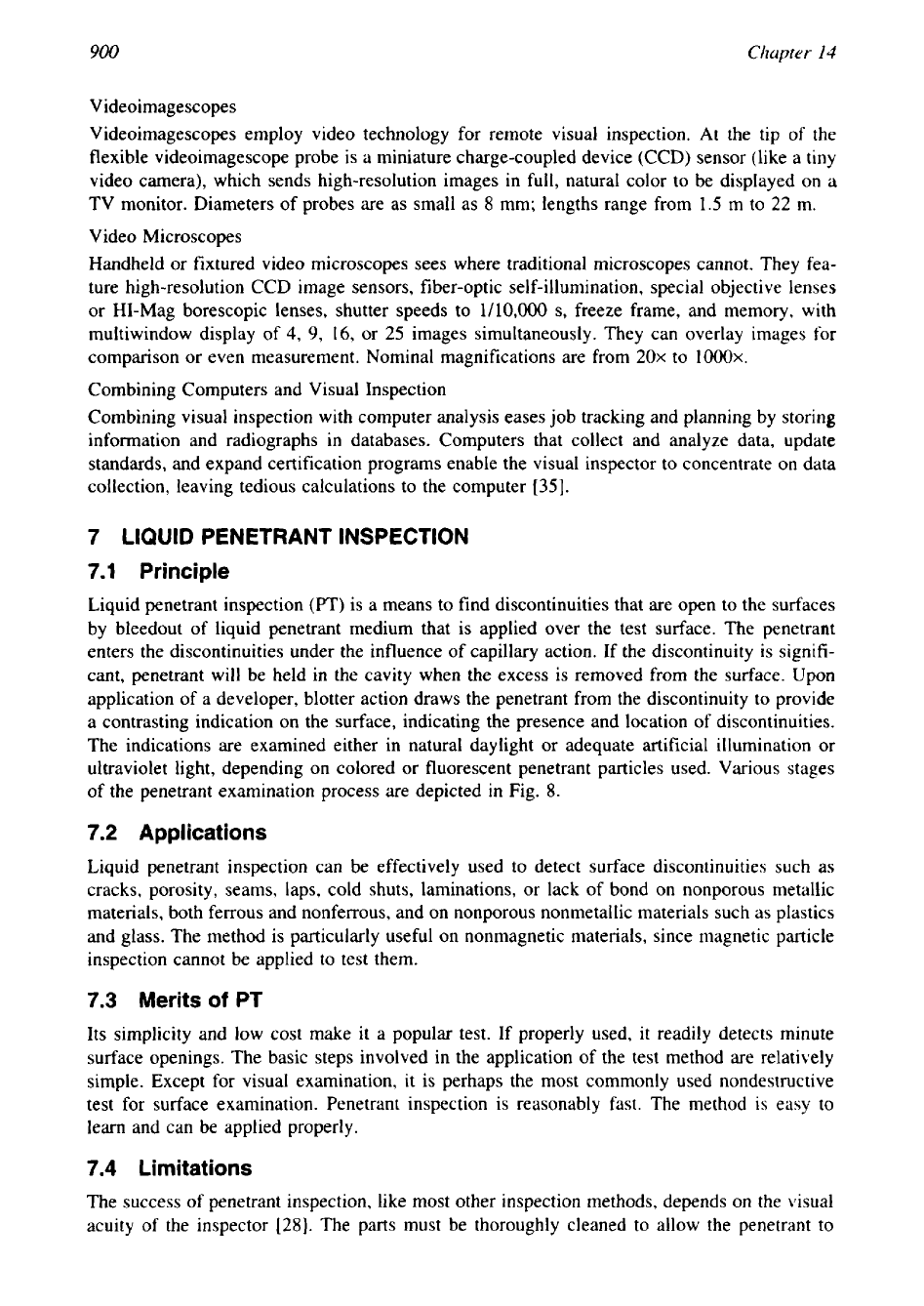
900
Chapter
14
Videoimagescopes
Videoimagescopes employ video technology for remote visual inspection. At the tip of the
flexible videoimagescope probe is a miniature charge-coupled device (CCD) sensor (like a tiny
video camera), which sends high-resolution images in full, natural color to be displayed on a
TV monitor. Diameters of probes are as small as
8
mm; lengths range from
1.5
m to
22
m.
Video Microscopes
Handheld or fixtured video microscopes sees where traditional microscopes cannot. They fea-
ture high-resolution CCD image sensors, fiber-optic self-illumination, special objective lenses
or HI-Mag borescopic lenses, shutter speeds to 1/10,000
s,
freeze frame, and memory, with
multiwindow display of
4,
9,
16,
or 25 images simultaneously. They can overlay images for
comparison or even measurement. Nominal magnifications are from 20x to 1OOOx.
Combining Computers and Visual Inspection
Combining visual inspection with computer analysis eases job tracking and planning by storing
information and radiographs in databases. Computers that collect and analyze data, update
standards, and expand certification programs enable the visual inspector to concentrate on data
collection, leaving tedious calculations to the computer
[35].
7
LIQUID PENETRANT INSPECTION
7.1
Principle
Liquid penetrant inspection (PT) is a means to find discontinuities that are open to the surfaces
by bleedout of liquid penetrant medium that is applied over the test surface. The penetrant
enters the discontinuities under the influence of capillary action. If the discontinuity is signifi-
cant, penetrant will be held in the cavity when the excess is removed from the surface. Upon
application of a developer, blotter action draws the penetrant from the discontinuity to provide
a contrasting indication on the surface, indicating the presence and location of discontinuities.
The indications are examined either in natural daylight or adequate artificial illumination or
ultraviolet light, depending on colored or fluorescent penetrant particles used. Various stages
of the penetrant examination process are depicted in Fig.
8.
7.2
Applications
Liquid penetrant inspection can be effectively used to detect surface discontinuities such as
cracks, porosity, seams, laps, cold shuts, laminations, or lack of bond on nonporous metallic
materials, both ferrous and nonferrous, and on nonporous nonmetallic materials such as plastics
and glass. The method is particularly useful on nonmagnetic materials, since magnetic particle
inspection cannot be applied to test them.
7.3
Merits
of
PT
Its simplicity and low cost make it a popular test. If properly used, it readily detects minute
surface openings. The basic steps involved in the application of the test method are relatively
simple. Except for visual examination, it is perhaps the most commonly used nondestructive
test for surface examination. Penetrant inspection is reasonably fast. The method is easy to
learn and can be applied properly.
7.4
Limitations
The success
of
penetrant inspection, like most other inspection methods, depends on the visual
acuity of the inspector [28]. The parts must be thoroughly cleaned to allow the penetrant to
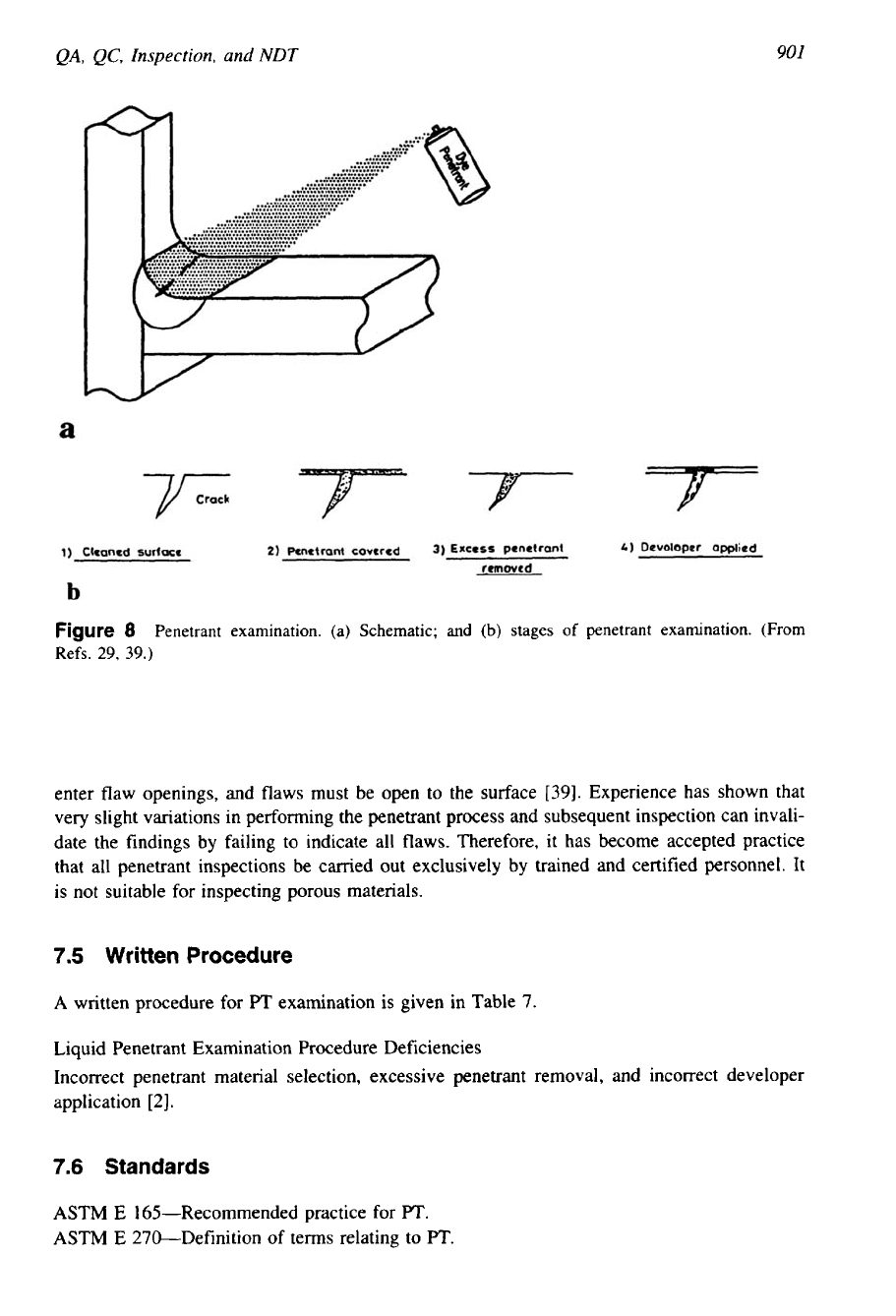
901
QA,
QC,
Inspection,
and
NDT
Figure
8
Penetrant examination. (a) Schematic;
and
(b)
stages
of
penetrant examination. (From
Refs.
29,
39.)
enter flaw openings, and flaws must be open to the surface
[39].
Experience has shown that
very slight variations in performing the penetrant process and subsequent inspection can invali-
date the findings by failing to indicate all flaws. Therefore, it has become accepted practice
that all penetrant inspections be carried out exclusively by trained and certified personnel. It
is not suitable for inspecting porous materials.
7.5
Written Procedure
A
written procedure for
PT
examination is given in Table
7.
Liquid Penetrant Examination Procedure Deficiencies
Incorrect penetrant material selection, excessive penetrant removal, and incorrect developer
application
[Z].
7.6
Standards
ASTM
E
165-Recommended practice for
PT.
ASTM
E
270-Definition of terms relating to
PT.
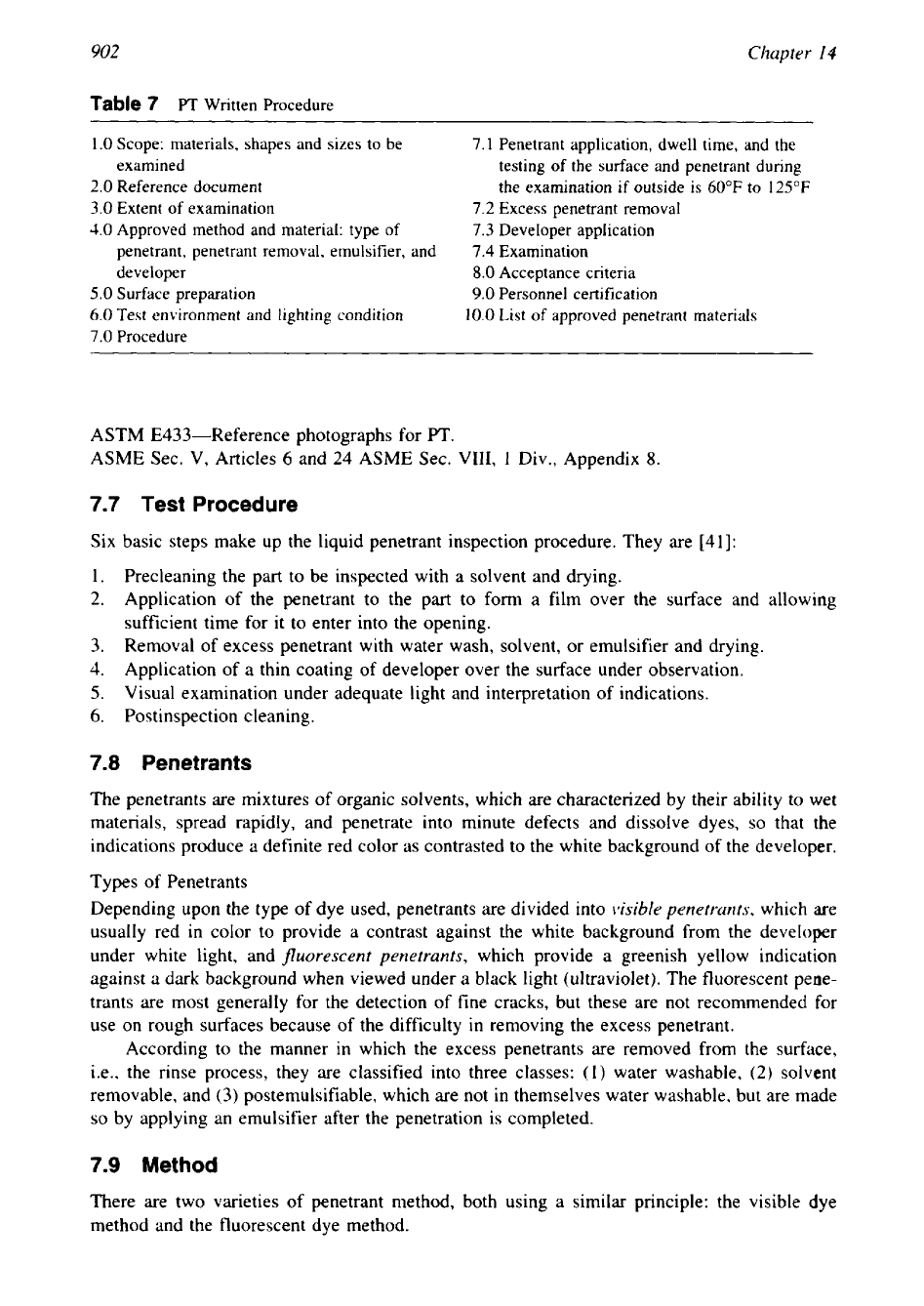
902
Chapter
14
Table
7
PT
Written Procedure
1.0
Scope: materials, shapes and sizes
to
be
7.1
Penetrant application, dwell time, and the
examined
testing of the surface and penetrant during
2.0
Reference document
the examination if outside is
60°F
to
125°F
3.0
Extent
of
examination
7.2
Excess penetrant removal
4.0
Approved method and material: type
of
7.3
Developer application
penetrant, penetrant removal, emulsifier, and
7.4
Examination
developer
8.0
Acceptance criteria
5.0
Surface preparation
9.0
Personnel certification
6.0
Test environment and lighting condition
10.0
List
of
approved penetrant materials
7.0
Procedure
ASTM E433-Reference photographs for
PT.
ASME Sec. V, Articles
6
and 24
ASME
Sec.
VIII,
1
Div., Appendix
8.
7.7
Test Procedure
Six basic steps make up the liquid penetrant inspection procedure. They are [41]:
1.
Precleaning the part to be inspected with a solvent and drying.
2.
Application of the penetrant to the part to form a film over the surface and allowing
sufficient time for it to enter into the opening.
3.
Removal of excess penetrant with water wash, solvent, or emulsifier and drying.
4.
Application of a thin coating of developer over the surface under observation.
5.
Visual examination under adequate light and interpretation of indications.
6.
Postinspection cleaning.
7.0
Penetrants
The penetrants are mixtures of organic solvents, which are characterized by their ability to wet
materials, spread rapidly, and penetrate into minute defects and dissolve dyes,
so
that the
indications produce a definite red color as contrasted to the white background
of
the developer.
Types of Penetrants
Depending upon the type of dye used, penetrants are divided into
visible
penetrants,
which
are
usually red in color to provide a contrast against the white background from the developer
under white light, and
fluorescent penetrants,
which provide a greenish yellow indication
against a dark background when viewed under a black light (ultraviolet). The fluorescent pene-
trants are most generally for the detection of fine cracks, but these are not recommended for
use on rough surfaces because of the difficulty in removing the excess penetrant.
According to the manner in which the excess penetrants are removed from the surface,
i.e., the rinse process, they are classified into three classes: (1) water washable,
(2)
solvent
removable, and
(3)
postemulsifiable, which are not in themselves water washable, but are made
so
by applying
an
emulsifier after the penetration
is
completed.
7.9
Method
There are two varieties
of
penetrant method, both using a similar principle: the visible dye
method and the fluorescent dye method.
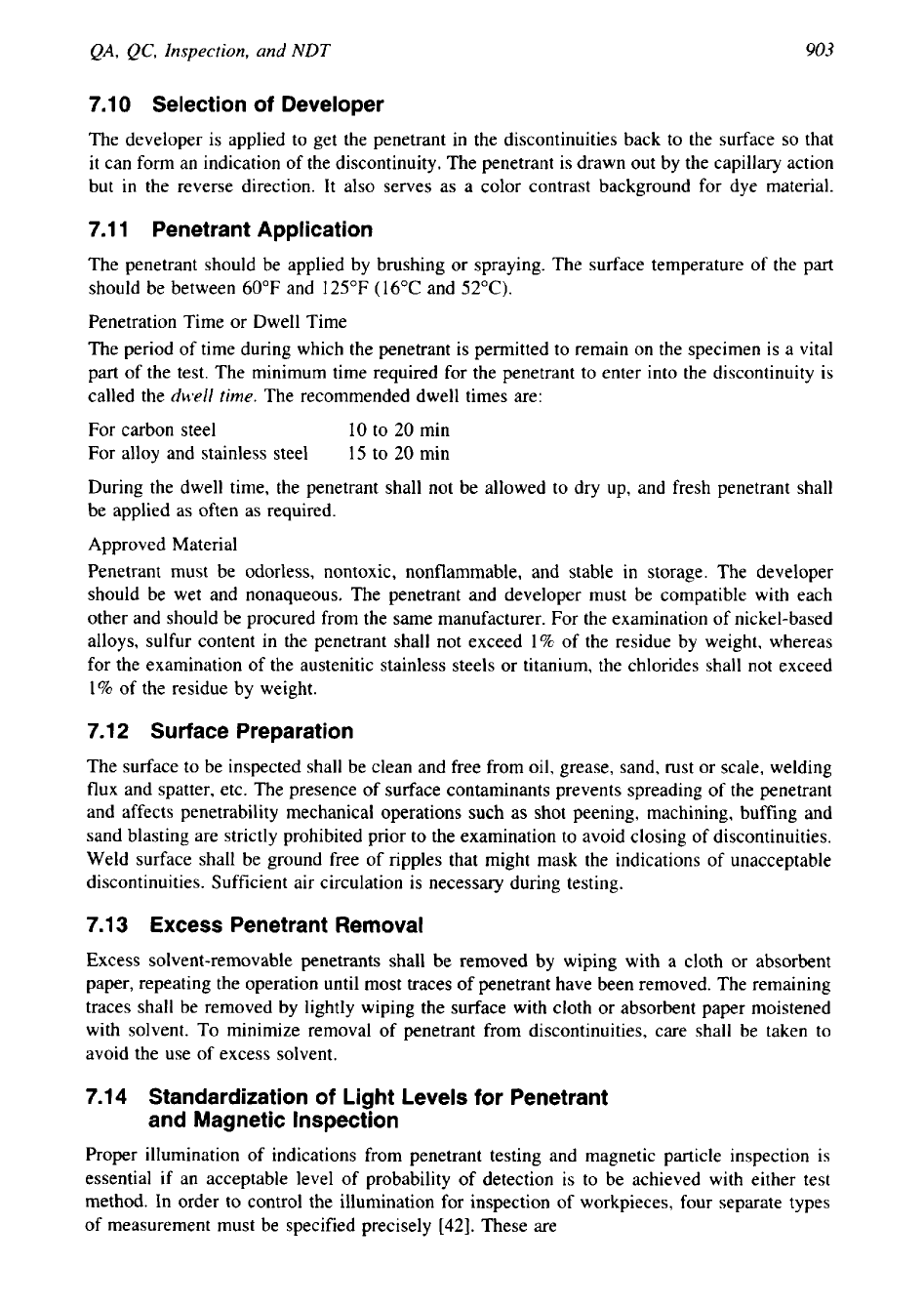
QA,
QC,
Inspection, and
NDT
903
7.1
0
Selection
of
Developer
The developer is applied to get the penetrant in the discontinuities back to the surface
so
that
it can form an indication of the discontinuity. The penetrant is drawn out by the capillary action
but in the reverse direction. It also serves as a color contrast background for dye material.
7.1
1
Penetrant Application
The penetrant should be applied by brushing or spraying. The surface temperature of the part
should be between 60°F and 125°F (16°C and
52°C).
Penetration Time or Dwell Time
The period of time during which the penetrant is permitted to remain on the specimen is a vital
part of the test. The minimum time required for the penetrant to enter into the discontinuity is
called the
dwell time.
The recommended dwell times are:
For carbon steel
10 to 20 min
For alloy and stainless steel
15
to
20
min
During the dwell time, the penetrant shall not be allowed to dry up, and fresh penetrant shall
be applied as often as required.
Approved Material
Penetrant must be odorless, nontoxic, nonflammable, and stable in storage. The developer
should be wet and nonaqueous. The penetrant and developer must be compatible with each
other and should be procured from the same manufacturer. For the examination of nickel-based
alloys, sulfur content in the penetrant shall not exceed 1%
of
the residue by weight, whereas
for the examination of the austenitic stainless steels or titanium, the chlorides shall not exceed
1%
of
the residue by weight.
7.1
2
Surface Preparation
The surface to be inspected shall be clean and free from oil, grease, sand, rust or scale, welding
flux
and spatter, etc. The presence of surface contaminants prevents spreading of the penetrant
and affects penetrability mechanical operations such as shot peening, machining, buffing and
sand blasting are strictly prohibited prior to the examination to avoid closing of discontinuities.
Weld surface shall be ground free of ripples that might mask the indications of unacceptable
discontinuities. Sufficient air circulation is necessary during testing.
7.1
3
Excess Penetrant Removal
Excess solvent-removable penetrants shall be removed by wiping with a cloth or absorbent
paper, repeating the operation until most traces of penetrant have been removed. The remaining
traces shall be removed by lightly wiping the surface with cloth or absorbent paper moistened
with solvent.
To
minimize removal of penetrant from discontinuities, care shall be taken to
avoid the use of excess solvent.
7.14
Standardization
of
Light Levels
for
Penetrant
and Magnetic Inspection
Proper illumination of indications from penetrant testing and magnetic particle inspection is
essential if an acceptable level of probability of detection is to be achieved with either test
method. In order to control the illumination for inspection of workpieces, four separate types
of measurement must be specified precisely
[42].
These are
